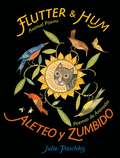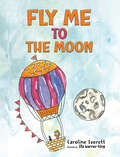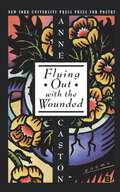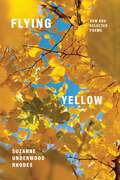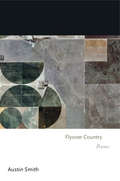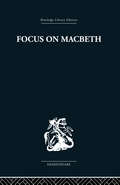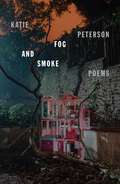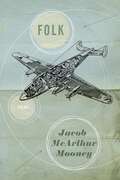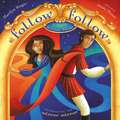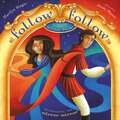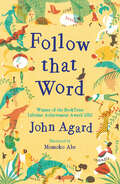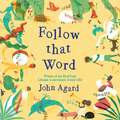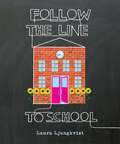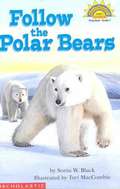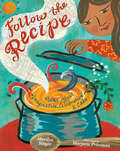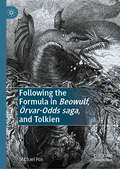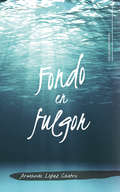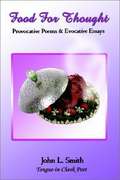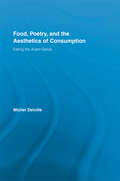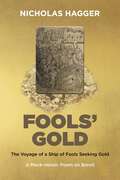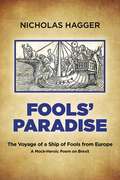- Table View
- List View
Fly Me to the Moon
by Caroline Everett‘The only thing to bother me Is being home in time for tea’. But Pip also yearns to soar through the air! Mad adventures in mad verses using interesting words and unusual vehicles, to transport us all away from the humdrum of the kitchen and the classroom. Lucky little Pip with his wild flights of fancy!
Flying Out With the Wounded
by Anne CastonThis collection of poems is striking in its powerful representation of humanity and its dramatic use of language. Anne Caston explores the inner recesses of the human mind and body, delving into the murky shadows where individuals fear to tread. The poems consider the nature of death, love, brutality, friendship, and much more. Caston plays with different points of view and keeps readers on their toes. The physicality of these moving and disturbing poems is sure to captivate lovers of poetry.
Flying Yellow: New and Selected Poems (Paraclete Poetry)
by Suzanne Underwood RhodesThe poems in Flying Yellow cry out for the day just out of reach, the day which unaccountably may in a moment or a season let down a joyful light into the obscurity of human trial. A hopeful belief in heaven and the end of suffering colors these profoundly spiritual, often uneasy, poems. Carried by musical currents that shape her work, Rhodes ventures into what she calls "the good dark stuff" of experience—good because the dark is where Christ went, willingly, to take it captive. Whether probing the meaning of her own personal traumas or those of historical figures like Mary Rowlandson and Dorothy Bradford; whether peeling back layers of habitual sight to see the natural world of robins and ghost crabs and shorelines more truly, she brings the reader alongside in each surprising encounter to see the possibilities of light.
Flyover Country: Poems (Princeton Series of Contemporary Poets #140)
by Austin SmithA new collection about violence and the rural Midwest from a poet whose first book was hailed as “memorable” (Stephen Burt, Yale Review) and “impressive” (Chicago Tribune)Flyover Country is a powerful collection of poems about violence: the violence we do to the land, to animals, to refugees, to the people of distant countries, and to one another. Drawing on memories of his childhood on a dairy farm in Illinois, Austin Smith explores the beauty and cruelty of rural life, challenging the idea that the American Midwest is mere “flyover country,” a place that deserves passing over. At the same time, the collection suggests that America itself has become a flyover country, carrying out drone strikes and surveillance abroad, locked in a state of perpetual war that Americans seem helpless to stop.In these poems, midwestern barns and farmhouses are linked to other lands and times as if by psychic tunnels. A poem about a barn cat moving her kittens in the night because they have been discovered by a group of boys resonates with a poem about the house in Amsterdam where Anne Frank and her family hid from the Nazis. A poem beginning with a boy on a farmhouse porch idly swatting flies ends with the image of people fleeing before a drone strike. A poem about a barbwire fence suggests, if only metaphorically, the debate over immigration and borders. Though at times a dark book, the collection closes with a poem titled “The Light at the End,” suggesting the possibility of redemption and forgiveness.Building on Smith’s reputation as an accessible and inventive poet with deep insights about rural America, Flyover Country also draws profound connections between the Midwest and the wider world.
Foamy Sky: A Bilingual Edition (slightly enlarged edition)
by Frederick Jackson Turner Miklos Radnoti Zsuzsanna Ozsvath"Alint új istenben kék egekbõl most széphangú orgonák zúgnak bennem, álomhegyeim sorra beszakadnak, most eljöttél hozzám hullottan mint a csillagok õsszel, mert úgy szeretlek szememben hordva fehérszakállú istenek végtelen életét és úgy tanulom meg a csókjaidat hivõn! mint vénasszonyok a kártyavetést. 1929. június 25. As bellowed sky-blue by a new-born god, gorgeous-voiced organs roar within my body, all my dream-mountains cave in one by one,- lately you came to me, a fallen star as stars in Fall, because I love you so I carry in my eyes that life eternal belonging to the snowy-bearded gods and thus I learn your kisses' sacrament, your priest! as wise old women tell our fates in cards. June 25, 1929"
Focus on Macbeth
by John Russell BrownFirst published in 1982. Macbeth exercises a strange influence over readers and theatre audiences: the words of the text offer no easy clue to meaning or significance and in dramatic structure the play is very different from other Shakespearean tragedies. Many kinds of study are needed in order to understand the tragedy of Macbeth and this book provides a wide range of studies that respect the individuality of the text and examine it from different viewpoints. Contents include: Themes and Structure; Characterization and Narrative, Visual Effects, Performance in the Eighteenth, Nineteenth and Twentieth Centuries; Historical and Political Background; Role of Witchcraft; Game Theory. Contributors include: John Russell Brown, Derek Russell Davis, Gareth Lloyd Evans, R A Foakes, Michael Goldman, Robin Grove, Peter Hall, Michael Hawkins, Brian Morris, D J Palmer, Marvin Rosenberg and Peter Stallybrass.
Fog and Smoke: Poems
by Katie PetersonPeterson unfurls the quotidian fabric of our lives, patterned with the difficulties of language and this moment.Confusion frames the human predicament. In Katie Peterson’s Fog and Smoke, confusion is, literally, our climate. Writing to and from the California landscape, Peterson sees fog and smoke as literal—one a habitual, natural weather event, the other an increasingly common aftereffect of the West’s drought-caused fires. But they are also metaphysical. Fog and smoke reflect the true conditions (and frustrations) of our ability to perceive and to connect. Peterson writes, “I’ve been speaking about it at a distance. / Now I want to talk about its thickness. / A person could get killed in here.” The collection moves through three sections: First, the poet follows her local fog’s cyclical journey of descent and dispersion. Second, in a sort of pastoral interlude, she travels widely, almost erratically, to the California desert, the greater world, and ancient history. Finally, she descends into the enclosed space of the household, and the increased confinement and intimacy of raising a child during the pandemic. Peterson unfolds the small moments that make up our lives and reveals the truths contained within them, and her poems capture the lyricism of our daily rhythms—the interruptions, dialogues, and epiphanies.
Folk
by Jacob McArthur MooneyThe two sections in Jacob McArthur Mooney&’s virtuoso collection – one rural in orientation, one urban – open an intricate conversation. Taking as its inciting incident the 1998 crash of Swissair Flight 111 off the coast of Nova Scotia, before moving to the neighbourhoods around Toronto&’s Pearson International Airport, Folk is an elaborately composed inquiry into the human need for frames, edges, borders, and a passionate probe of contemporary challenges to identity, whether of individual, neighbourhood, city, or nation. Mooney examines the fraught desire to align where we live with who we are, and asks how we can be at home on the compromised earth. This is poetry that poses crucial questions and refuses easy answers, as it builds a shimmering verbal structure that ventures &“beyond ownership or thought.&” Mooney&’s distinctive voice is seriously unsettling, deeply appealing, and answerable to our difficult times.
Follow Follow: A Book of Reverso Poems
by Marilyn SingerRead these clever poems from top to bottom and they mean one thing. Then reverse the lines and read from bottom to top and they mean something else;it is almost like magic! A celebration of sight, sound, and story, this book is a marvel to read again and again.
Follow Follow: A Book of Reverso Poems
by Marilyn SingerNow one of Booklist's 30 Best Books of the Year!"Genius!" – Wired.com“Marilyn Singer's verse in Follow Follow practically dances down each page . . . the effect is miraculous and pithy.” – The Wall Street JournalOnce upon a time, Mirror Mirror, a brilliant book of fairy tale themed reversos–a poetic form in which the poem is presented forward and then backward–became a smashing success. Now a second book is here with more witty double takes on well-loved fairy tales such as Thumbelina and The Little Mermaid.Read these clever poems from top to bottom and they mean one thing. Then reverse the lines and read from bottom to top and they mean something else–it is almost like magic!A celebration of sight, sound, and story, this book is a marvel to read again and again.
Follow that Word
by John AgardThe father of performance poetry, John Agard, brings you a collection of riotously funny poems. Follow that Word is a celebration of imagination and demonstrates the true diversity of language.A dazzling collection of over sixty poems, Follow That Word delivers John Agard's musings on people and places from the modern and historical world, this wonderful collection that can be rediscovered over and over again. With gorgeous black-and-white illustrations from Momoko Abe, these poems truly come to life for all children, and this collection belongs on every bookshelf.'It's been around from Creation dawn,And it only takes two to catch on, Try it people, and you'll soon see,This is a dance that can set you free,It's called the dance of diversity.'Reviews for Half-caste, and Other Poems: 'Rollicking Caribbean-flavored rhythms combined with serious matters such as racism define poet extraordinaire, Agard.' - VoyaA performance poet, Agard uses his rhyme, repetition and refrains that make his work sing...Skilful use of humour to get his serious points across. - The Book Horn Inc
Follow that Word
by John AgardThe father of performance poetry, John Agard, brings you a collection of riotously funny poems. Follow that Word is a celebration of imagination and demonstrates the true diversity of language.A dazzling collection of over sixty poems, Follow That Word delivers John Agard's musings on people and places from the modern and historical world, this wonderful collection that can be rediscovered over and over again. With gorgeous black-and-white illustrations from Momoko Abe, these poems truly come to life for all children, and this collection belongs on every bookshelf.'It's been around from Creation dawn,And it only takes two to catch on, Try it people, and you'll soon see,This is a dance that can set you free,It's called the dance of diversity.'Reviews for Half-caste, and Other Poems: 'Rollicking Caribbean-flavored rhythms combined with serious matters such as racism define poet extraordinaire, Agard.' - VoyaA performance poet, Agard uses his rhyme, repetition and refrains that make his work sing...Skilful use of humour to get his serious points across. - The Book Horn Inc
Follow the Line to School
by Laura LjungkvistFollow the line from the science corner to the library, from recess to show-and-tell. This new Follow the Line book-illustrated in Laura Ljungkvist's signature line style-takes children on a colorful, comforting, and altogether fun romp through the school day. With its unique modern design and engaging interactive text, Follow the Line to School is sure to appeal to both new and returning students.
Follow the Polar Bears
by Sonia W. BlackFollow the polar bears from hibernation through cubs growing and moving on. Learning to read is one of the most important accomplishments of early childhood. Hello Reader! books are designed to help children become skilled readers who like to read. Beginning readers learn to read by remembering frequently used words like "the," "is," and "and"; by using phonics skills to decode new words; and by interpreting picture and text clues. These books provide both the stories children enjoy and the structure they need to read fluently and independently. A fun way to learn about polar bears with picture descriptions added.
Follow the Recipe: Poems About Imagination, Celebration, and Cake
by Marilyn SingerA joyful collection of poems by the author of Mirror Mirror, in the form of recipes both simple and allegorical.This delicious collection of poems by the innovative Marilyn Singer is accompanied by vibrant splashy artwork by two-time Caldecott honoree Marjorie Priceman. Presented in a small-size format to appeal to older readers (as well as young), the book has the look of a vintage collector's compendium that includes pictures, ephemera and annotations to add interest. Even young children are familiar with recipes--a series of steps to help them make something--and the book begins with simple dishes and ideas (such as a recipe for reading a recipe and a recipe for measuring), and then adds more ideas and grows in sophistication until the last recipes broach lofty concepts (such as a recipe for understanding and a recipe for peace). A treasure of words and images and ideas.
Following A Lark
by George Mackay Brown George Mackay-BrowA country boy creeps unwillingly to school on a lark-filled summer morning. Norse crusaders, preparing to sail on Earl Rognvald's crusade in 1151 break into the burial chamber at Maeshowe seeking treasure, and cut runes in its massive stones. And the famous Iceland poet Thorbjorn leaves his farm to join the group of poets whose lyrics stud like gems that famous pilgrimage. The ancient northern ceremonies of solstice and equinox, Easter and Yule, are brought to vivid life in the poems collected in this book, and so also are some of the holidays of the Christian calender. The cycle of seasons is more noticeable in the north, especially perhaps winter, the time of story-telling and music. There are tributes to the great poet of winter, Robert Burns, and a celebration of the Irish veteran of the Peninsular War who founded a tavern in Orkney in 1821. The life of an islander is 'sweetly compacted' in The Laird and the Three Women.
Following A Lark
by George Mackay BrownA country boy creeps unwillingly to school on a lark-filled summer morning. Norse crusaders, preparing to sail on Earl Rognvald's crusade in 1151 break into the burial chamber at Maeshowe seeking treasure, and cut runes in its massive stones. And the famous Iceland poet Thorbjorn leaves his farm to join the group of poets whose lyrics stud like gems that famous pilgrimage. The ancient northern ceremonies of solstice and equinox, Easter and Yule, are brought to vivid life in the poems collected in this book, and so also are some of the holidays of the Christian calender. The cycle of seasons is more noticeable in the north, especially perhaps winter, the time of story-telling and music. There are tributes to the great poet of winter, Robert Burns, and a celebration of the Irish veteran of the Peninsular War who founded a tavern in Orkney in 1821. The life of an islander is 'sweetly compacted' in The Laird and the Three Women.
Following the Formula in Beowulf, Örvar-Odds saga, and Tolkien
by Michael FoxFollowing the Formula in Beowulf, Örvar-Odds saga, and Tolkien proposes that Beowulf was composed according to a formula. Michael Fox imagines the process that generated the poem and provides a model for reading it, extending this model to investigate formula in a half-line, a fitt, a digression, and a story-pattern or folktale, including the Old-Norse Icelandic Örvar-Odds saga. Fox also explores how J. R. R. Tolkien used the same formula to write Sellic Spell and The Hobbit. This investigation uncovers relationships between oral and literate composition, between mechanistic composition and author, and between listening and reading audiences, arguing for a contemporary relevance for Beowulf in thinking about the creative process.
Fondo en fulgor
by Armando López CastroLa sombra se hace verbo. El fondo de lo abisal se despliega como la aparición súbita de la otra voz en el tejido de la escritura. Esta fulguración inmediata de lo oscuro corresponde por naturaleza a la palabra poética, que hace que algo esté presente por su ausencia. Debido a la oscuridad primordial que los rodea, los poemas de Fondo en fulgor (2019) viven en el límite entre lo dicho y lo no dicho, instalándose en la iluminación de lo más real, que es lo que impulsa el lenguaje y revela su sentido más oculto.
Food Trucks!
by Mark Todd"Talk about your meals on wheels!" A convoy of comic food trucks is heading your way, serving up a mouthful of good eats with a side of humor and verse. They've got everything from french fries to falafel. You can sample sushi. Build a burger. Eat an empanada! There's a food truck flavor to satisfy every appetite in this comically illustrated picture book with rhyming text. A fun and informative homage to tasty treats and transportation. Additional fun facts on food history and nutrition are also peppered throughout the book.
Food for Thought: Provocative Poems and Evocative Essays
by John L. Smith"Brunch Neither an early breakfast, nor a fashionable late lunch, But rather eaten on the ill-conceived, hopeful hunch, That eating the one single meal, will make you thinner, If to-night you skip your formal, sit-down Sunday dinner. But 1 predict that this will be far from true; For I been watching closely everyone of you. Scoffing bacon, egg, sausage, chicken and danish down. Enough to make the Duchess of York, groan and frown. The problem is, that in having paid table d'hote, A sense of gastronomic proportion is now totally remote, As you eat heartily to get your money's worth. You'll bloat your tummy and backside girth Try to lose the ugly weight you've gained, if you are able, By splitting your sides with laughter while sitting at the table. By applauding each act with an energetic, standing ovation, Much easier than a fortnight of painful, near-starvation True this poem is but one extended pun. And may even make you want to scream, cut and run; But nowadays where can you read, hear and imagine so much fun. So squeaky clean, and not the usual, very crude and very dumb."
Food, Poetry, and the Aesthetics of Consumption: Eating the Avant-Garde (Routledge Studies in Twentieth-Century Literature)
by Michel DelvilleFrom Plato’s dismissal of food as a distraction from thought to Kant’s relegation of the palate to the bottom of the hierarchy of the senses, the sense of taste has consistently been devalued by Western aesthetics. Kant is often invoked as evidence that philosophers consider taste as an inferior sense because it belongs to the realm of the private and subjective and does not seem to be required in the development of higher types of knowledge. From a gastrosophical perspective, however, what Kant perceives as a limitation becomes a new field of enquiry that investigates the dialectics of diet and discourse, self and matter, inside and outside. The essays in this book examine the importance of food as a pivotal element – both materially and conceptually – in the history of the Western avant-garde. From Gertrude Stein to Alain Robbe-Grillet and Samuel Beckett, from F.T. Marinetti to Andy Warhol, from Marcel Duchamp to Eleanor Antin, the examples chosen explore the conjunction of art and foodstuff in ways that interrogate contemporary notions of the body, language, and subjectivity.
Fools' Gold: The Voyage of a Ship of Fools Seeking Gold - A Mock-Heroic Poem on Brexit and English Exceptionalism
by Nicholas HaggerIn Fools&’ Paradise Nicholas Hagger presented the UK&’s attempt to leave the EU under Prime Minister Theresa May in terms of the voyage of Sebastian Brant&’s 1494 Ship of Fools heading with a mutinous crew for the illusory, nonexistent paradise of Narragonia. His mock-heroic satirical poem on the political chaos surrounding the most important UK decision since the Second World War is in rhymed heroic couplets, in the tradition of Dryden and Pope. In this sequel, Fools&’ Gold, Hagger focuses on the beginning of Boris Johnson&’s premiership, the promises that won him the 2019 General Election with an 80-seat majority, and his removal of the UK from the EU, only to be engulfed by the deadly Covid pandemic which has devastated the UK economy. Hagger describes the catastrophic national events in heroic blank verse, which befits the darkening mood. The UK public has been promised a new Golden Age, an age of plenty, and it remains to be seen whether there will be prosperity for all - gold - now that the UK is facing colossal debt outside the EU, or whether the promises will turn out to be worthless iron pyrites: fools&’ gold.
Fools' Paradise: The Voyage of a Ship of Fools From Europe, A Mock-Heroic Poem on Brexit
by Nicholas HaggerIn Fools' Paradise, a mock-heroic poem on Brexit which complements his masque King Charles the Wise, Nicholas Hagger presents the most important British event since the Second World War: the Brexiteers' struggle to wrest control of the UK's laws, borders, money and trade from the EU and turn the UK into a more prosperous paradise.In 16 cantos and an epilogue of heroic couplets with an epic tone, he narrates the 2018 Chequers compromise and its aftermath: the EU's opposition, lack of internal support, looming &‘no deal' and requests for extensions that keep the UK in the EU. He shows the UK Ship of State as manned by a squabbling crew sailing for an illusory paradise and too riven by division to reach agreement. The dream all were promised seems undeliverable. In the tradition of the social satire of Dryden and Pope, the elevated style is undermined by a recurring image of the Ship of Fools in Sebastian Brant's 1494 Swiss poem Ship of Fools (Das Narrenschiff), which makes a chaotic voyage from Europe to an illusory paradise across the waves. It becomes apparent that all on the UK Ship of State are to some extent living in a fools' paradise. Focusing on the historic decision to leave Europe that if carried through would have immense repercussions for coming generations, Nicholas Hagger presents the warring factions on the UK Ship of State and in true Universalist manner foresees a resolution of the conflict in the reconciliation of a coming united world. This is an astonishing poem that approaches the most important national event of our time in the spirit of Tennyson and gets to the heart of the UK's national predicament.
